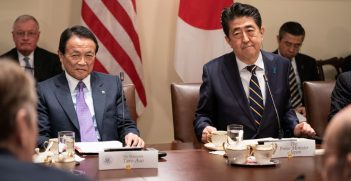Japan’s Risky New Resource Strategy

The second Japan–Australia Economic Ministerial Dialogue was held on 10 January in Melbourne. Before the meeting, Japan’s Minister of Economy, Trade and Industry Hiroshi Kajiyama described Australia as a key strategic partner for Japan.
The Minister noted this year’s discussions focus on collaboration in hydrogen and “carbon-recycling,” in addition to trade and other issues. The introduction of “carbon recycling” to Australia–Japan bilateral dialogue reflects a big change in Japan’s international resources strategy.
Japan has spent huge sums of money on energy security policies to diversify the energy sources used to fuel its economy, and the locations from which it imports fuel. The Japanese nuclear power program was a central plank of this mission prior to the Fukushima tsunami and nuclear disaster of 2011.
The Japanese government is now tackling climate change in its resource strategy by introducing a suite of policies it labels ‘carbon recycling’. In doing so, Japan is linking its technology-centred approach to climate change mitigation to long-standing energy security policies that enjoy legitimacy across all branches of government.
Australia as a key partner
Japan’s ‘carbon recycling’ agenda includes support for technologies designed to capture carbon dioxide and use it to generate a range of commodities including chemicals, fuels and concrete products.
Australia has long been a partner in Japan’s resource strategy, gaining billions of dollars in investment in natural gas, coal, and increasingly rare earth elements. It is emerging as a key partner in the new ‘carbon recycling’ initiative.
On 25 September 2019, the then minister for Resources and Northern Australia Matt Canavan signed a Memorandum of Cooperation to explore joint research and development into technologies that see ‘carbon dioxide as a resource, rather than viewing it merely as a waste product’. The Japan–Australia Energy and Resources Dialogue was also created on 16 June as a platform to facilitate planning and implementation.
Japan and Australia are natural partners in tackling climate change. Australia has the potential to be a zero-carbon export superpower, and Japan is a key technology provider to the world. Hydrogen produced by renewable energy is a potential long-term technology for decarbonising industrial sectors including steel. Japan has deployed electric vehicles more rapidly than Australia and uses energy efficiently. The machinery of government in Japan is also better geared towards developing green industry policies. Australia, on the other hand, has more experience in managing the uptake of renewables in competitive electricity markets.
‘Carbon recycling’ as a risky bet
But Japan’s ‘carbon recycling’ strategy carries real risks. The rate of reduction in greenhouse gas emissions needed to minimise the risk of catastrophic climate change is steep. Global commitments under the Paris Agreement lead to expected temperature increases of 3.2 degrees Celsius within the lifetime of a child born today. To meet a 1.5 degree global warming target, countries need to decrease carbon dioxide emissions globally by 7.6 percent every year between now and 2030. If delayed even by five years, the rate increases to 15.4 percent.
The world is going to burn large quantities of fossil fuels for many decades to come, and it makes sense to invest in technologies that might buy more time. But collaboration on long-term solutions is not a substitute for deploying existing technologies — such as in wind, solar photovoltaics, and energy efficiency — to achieve zero-net emissions as quickly as possible.
It is also not clear what the long-term benefits of ‘carbon recycling’ will be. If carbon dioxide is used to make fuels, it will re-enter the atmosphere if the fuels are burned without additional capture and storage efforts. The Japanese government’s own explanations of its new resources strategy show that one goal is to enable investment in fossil fuel production currently made marginal by environmental costs, increasing the global supply of fossil fuels.
Japan also supports building a hydrogen supply chain using fossil fuels. But even with carbon capture and storage technologies — which Japan’s ‘carbon recycling’ strategy emphasises — hydrogen can be no better than burning fossil fuels.
Worryingly, Japan’s new resources strategy also includes support for the construction of coal plants. The Japanese government remains a large financer of thermal coal plants in developing countries. Japan has been criticised for supporting coal projects that are unlikely to operate for their projected lifetimes. Many Japanese companies are postponing or cancelling coal projects at home because of financial risks and exiting the coal industry abroad. Doubling down on the financing of coal technology increases money flowing to projects that are increasingly subject to stranded asset risk.
Ultimately what matters is the rapid deployment of zero-carbon technologies at scale. Australia and Japan are natural partners in this effort. But it is crucial to assess whether technologies can make a real contribution to decarbonisation. And long-term technology collaboration cannot distract governments in Japan and Australia from collaborating to deploy low carbon technologies already available as quickly as possible.
Llewelyn Hughes is Associate Professor at the Crawford School of Public Policy, The Australian National University.
This article was originally published in East Asia Forum and can be viewed here.





